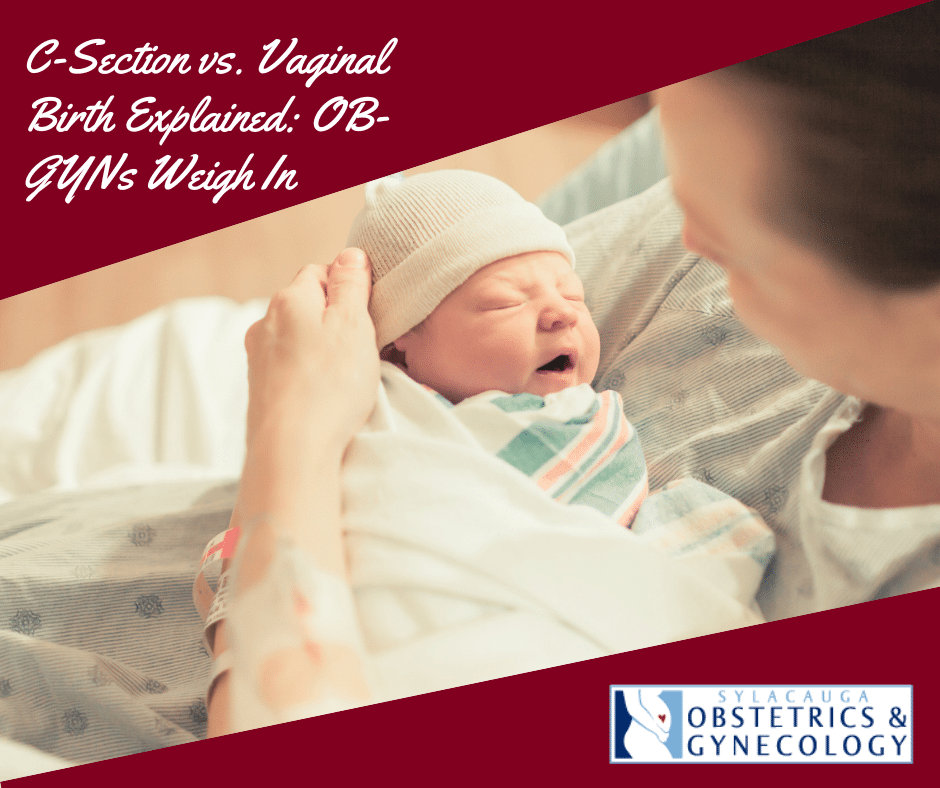
17 Aug C-Section vs. Vaginal Birth Explained: OB-GYNs Weigh In
The birth of a child is one of the most important, exciting, and—let’s be honest—intimidating times of your life. It’s natural to have questions and concerns about labor and delivery, even if you’ve been through it before. After all, introducing a new child to the world is an experience that can’t be matched. This leads many expecting mothers to seek help weighing the pros and cons of C-section vs. vaginal birth.
When certain medical complications make vaginal delivery too risky, cesarean deliveries can safeguard the health of you and your baby. But can you choose to have a C-section? Is it right for you? We’re here to help you understand this procedure, when we recommend it, and how you can speak to your OB-GYN about your options!
Everything You Need to Know When Weighing C-Section vs. Vaginal Birth
A C-section is a surgical procedure that involves delivering your baby through abdominal and uterine incisions. Most of the time, you’ll be given regional anesthesia, also known as an epidural or spinal block, that numbs the lower part of your body. This way, you’ll be awake when your baby is born.
Understanding Your Delivery Options
Every birth is unique, and making a birth plan is an important part of your journey. Talk to your OB-GYN about your concerns, preferences, and goals!
Planned or Elective C-Sections
In some cases, vaginal delivery can be a danger to a pregnant person’s health. Your doctor might schedule a C-section if they know it would be safer for medical reasons. Throughout your pregnancy, your doctor will keep track of your health and wellness, as well as any medical conditions you have, to make an informed recommendation.
The most common reasons for planning a C-section include:
- You have a high-risk pregnancy, including medical conditions like diabetes, high blood pressure, or heart disease
- The baby is situated feet-first instead of head-first (breech presentation)
- You’ve previously had a C-section
- You’re pregnant with multiples
- The baby is especially large
Emergency C-Sections
Being prepared is important, but labor doesn’t always go as planned. Sometimes, the baby needs to be delivered right away for the health and safety of the child and the mother. An unplanned or emergency C-section may be ordered at any stage of labor to protect you and your baby. The procedure is the same, though it is usually completed more quickly.
Common reasons for an unplanned or emergency C-section include:
- Prolapsed umbilical cord (the umbilical cord drops into your vagina before the baby)
- Placenta abruption (the placenta detaches from the wall of the uterus)
- Breech birth or other forms of distress on the baby
- Severe bleeding or maternal hemorrhage
- Extremely long or delayed labor
Vaginal Birth
Babies delivered vaginally are born after you go through active labor, an experience involving uterine contractions that move the baby down toward the vaginal opening. Some women choose to go through this process with painkillers, like an epidural, while others prefer a medication-free birth.
There is no right or wrong answer when it comes to pain relief during vaginal birth, only what works best for you. It’s an important conversation to have with your OB-GYN and your family!
Your Cesarean Delivery Questions Answered
Is it Better to Have a Natural Birth or C-Section?
Let’s start by saying this: the goal of any birth is to deliver a healthy baby, and any method of delivery is valid. As long as a baby is born, it is “natural”—so don’t feel like you’ve done something wrong if a C-section is necessary. That said, unless there is a medical reason to avoid it, we almost always recommend vaginal birth.
Benefits of vaginal birth include:
- The baby may be exposed to beneficial healthy bacteria in the vaginal canal
- Generally much safer in healthy or low-risk pregnancies
- Recovery time is usually shorter and less painful
- Smaller chance of maternal health complications
What Are the Disadvantages of C-Sections for the Baby?
Potential risks to the baby are minimal, but may include an increased chance of breathing problems like asthma, according to some research. It is thought that this is because the process of labor and vaginal delivery helps the baby release fluid from its lungs. However, a more recent study suggests that this may not actually be the case.
Most of the possible disadvantages of a C-section are to the mother. Like any surgical procedure, C-sections carry increased risks, such as blood clots, infection of the uterine or abdominal incisions, and injury to other organs. However, complications are rare.
Recovering is usually more difficult, and many women are likely to have C-sections for any future pregnancies once they’ve had one. Future pregnancies may be considered high-risk if you’ve had one cesarean delivery, but not always.
However, in certain situations, C-sections can be lifesaving, outweighing these risks. Your health care provider will discuss all of these considerations with you to ensure you’re fully informed.
Can You Choose to Have a C-Section?
Some women request to have a C-section, often because they are worried about the pain and difficulty of labor. However, it’s almost always recommended to try vaginal delivery when there isn’t a medical reason to avoid it. If you’re feeling anxiety about giving birth, talk to your OB-GYN! We can connect you with numerous resources and options to ease your fears, prepare you, and ensure that you feel confident and empowered in your birth journey!
Gain a Partner in Your Labor & Delivery Journey
Your OB-GYN should be a wealth of information, support, and expertise as you enter into parenthood. At Sylacauga OB-GYN, we pride ourselves on our big city care and small town doctors who are always there for you. Whether it’s your first baby or your fifth, we’ll be by your side throughout your journey to ensure your little one has the safest possible introduction to the world.
Award-Winning Obstetrics in Sylacauga, Alabama
Our OB-GYNs are proud to serve the women of Sylacauga, Talladega, Phenix City, Childersburg, and the entire Coosa Valley area of Alabama. We strive to bring world-class women’s health services right here to our very own community so you don’t have to travel all the way to Birmingham. To schedule your first appointment, call our team at 256-249-6995 or contact us online.


